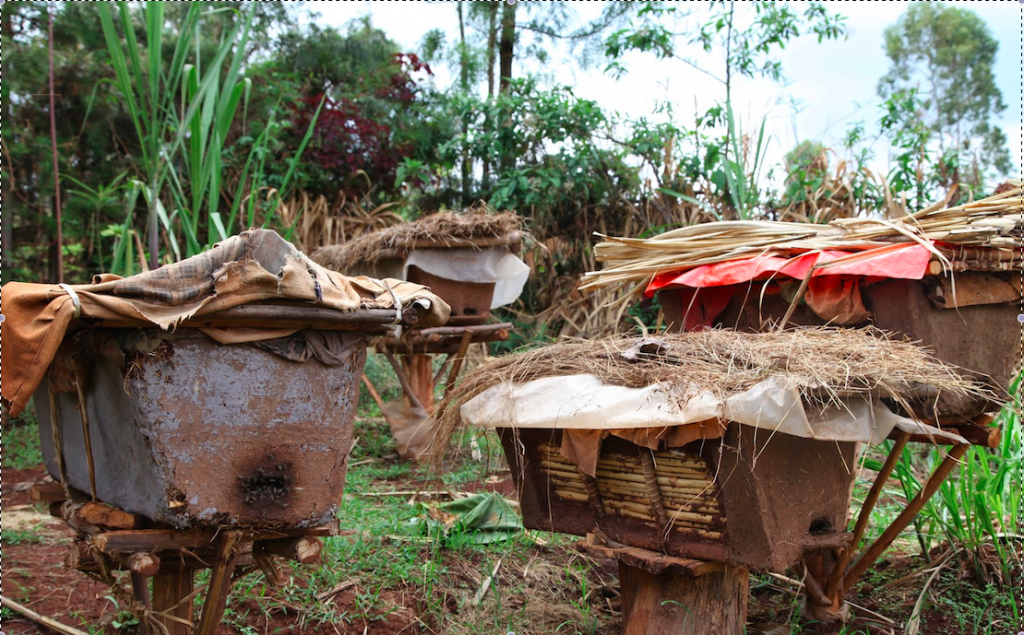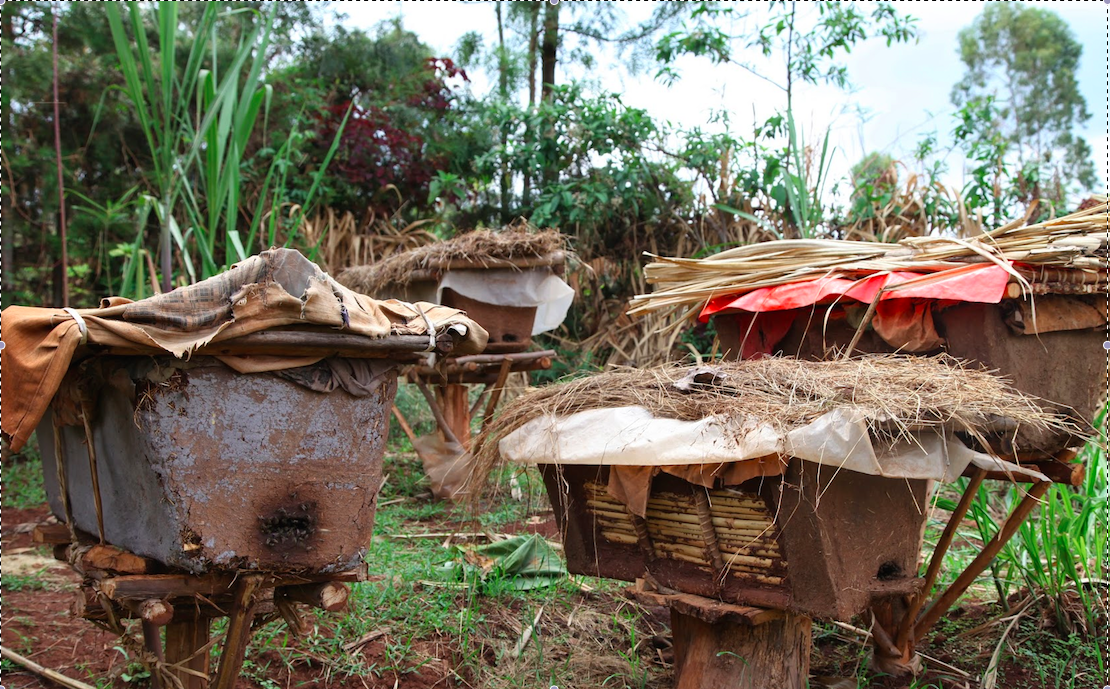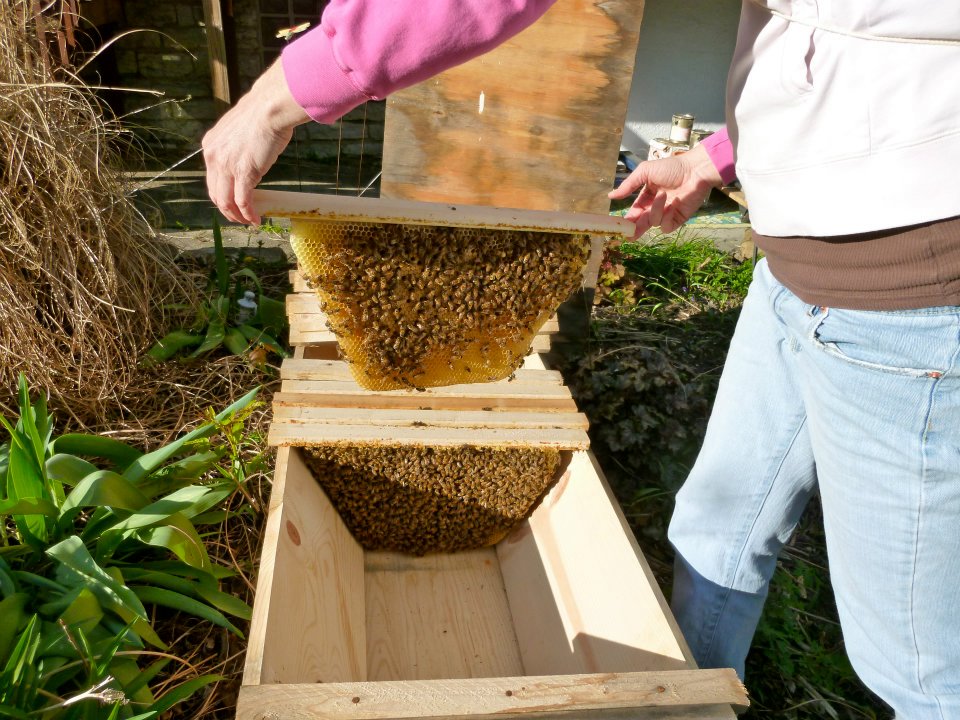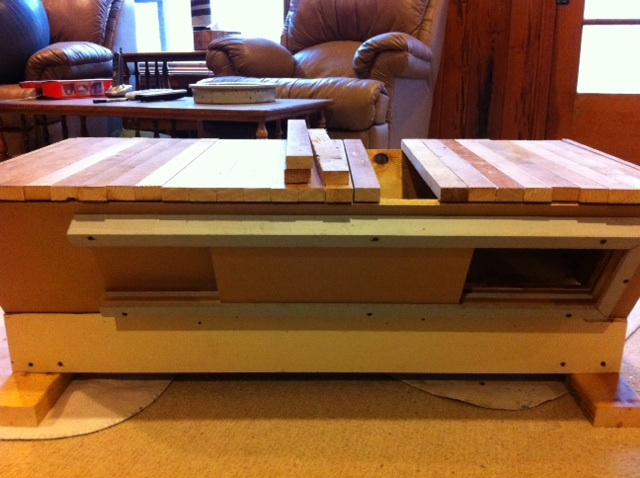
I simply love these hives because they’re made from indigenous material and without power tools. I plan to make a few using bamboo and thatch.

I like to construct my top-bar hives from rough-cut cedar fencing. The bees like the smell of the cedar—even as I construct, the bees investigate—and they like to hang out on the rough-cut grain. And, unlike pine, the cedar ages so gracefully. Pine gets sort of dull as it ages whereas cedar patinas.
However, this year, a number of my top-bar hives constructed with cedar fencing toppled over in high winds. That is definitely not good. In a few cases, I’ve gone to some elaborate means to keep the hives upright. But I still worry about them when the winds pick up…so, I’ve got to figure out a way to reduce the likelihood that the hives will tip over.
I’ve tried anchoring some of the hives with bungee cords and stakes. Others I’ve weighed down with a million pounds of rocks. But I’ve got to find a better, more aesthetically appealing way (you know, Reader, although my hives are simple, they’re also beautiful to my eye…and that’s very important to me. I need things to look good).
The hives I built years ago of pine don’t topple…probably because those hives are heavier. I think the lightness of the cedar fencing is at the root of the toppling problem…so, when I had some free time yesterday afternoon, I headed to Home Depot where I found heavier cedar. The new cedar lumber is gorgeous…it’s rough cut on one side and smooth on the other. It smells awesome. It’s thicker and heavier than the fencing, which will provide the bees with more insulation. Yes, it’s twice as expensive (still not enough to freak out over), but I think it’s worth it for the aesthetics, for the security it gives the bees, and for my own peace of mind.


The newly forming hive pictured above belongs to my friend Nicola. Her powerhouse hive is going gangbusters this year. When the original colony (a swarm we captured together in 2011) ran out of room in its current hive box, it began creating drones by the boatloads. When it set about creating another queen, Nicola set about splitting the hive in two.
I keep thinking that I’d like to switch all my hives to top-bar hives. If all the hives I manage were in my yard, or if all the hives were placed in locations closer to where I live, I’d probably drift away from the Langs. But many of my hives live far away. Which means I can’t get to them each week in order to inspect them. And that’s the key to managing TBHs: regular and diligent management.
To my mind, the only drawback to a TBH is that its space is limited. If the beekeeper neglects a TBH, the bees will soon outgrow their limited space, and they’ll likely swarm. And there goes hopes for honey. And I’m not ashamed to say that honey is a big deal to me. I want it. I don’t need tons of it, but I definitely want honey.
On the upside: Limiting space also means limiting the number of bees living in the hive…which makes for a more pleasant visit when it comes time to inspect.
AND…I have not yet lost a single colony from my four TBHs. Which is rather incredible.
Probably 30% of my colonies living in Langstroth hives die.
Some colonies that I’ve cut out from structures and placed in Langs abscond. When I’ve captured those colonies and put them back in their Lang hive, they abscond again. When I capture them again and place them in TBHs, they stay. And live with enthusiasm. I simply believe that the TBH makes for happier bees and happier beekeepers.
The minute I learned about top-bar hives, something drew me to them. And something keeps drawing me. I’ve learned to pay attention to such attractions, so this year I plan to double the number of my TBHs. I’m building them like crazy. Sawdust is everywhere. So, if you ask for my suggestion, Reader, I suggest you begin keeping bees in top-bar hives.

Kim and Bob joined us for pizza last night, but before we headed out we headed down into their basement where Bob keeps his shop. We wanted to see the progress on his top-bar hives. Well, they’re as good as finished…and, I must admit, they’re really wonderful.
Bob found some plans online that he liked and built two hives from scrap lumber (I’ll ask him for the site address so I can link it here). I don’t think these took him long to build, but then, he’s sort of a professional at these things. It would probably take me an eternity. And much aggravation. But, as you can see here, it doesn’t seem to have challenged Bob all that much.

Bob plans on painting the hives (I told you he’s sort of particular) because the material he used wasn’t designed for holding up outside. They’re gonna be green…the color of their leftover house paint…which is two gorgeous shades of green. I’ll post a picture of the finished hives when we introduce the bees to it, okay? But this is what it looks like right now:

